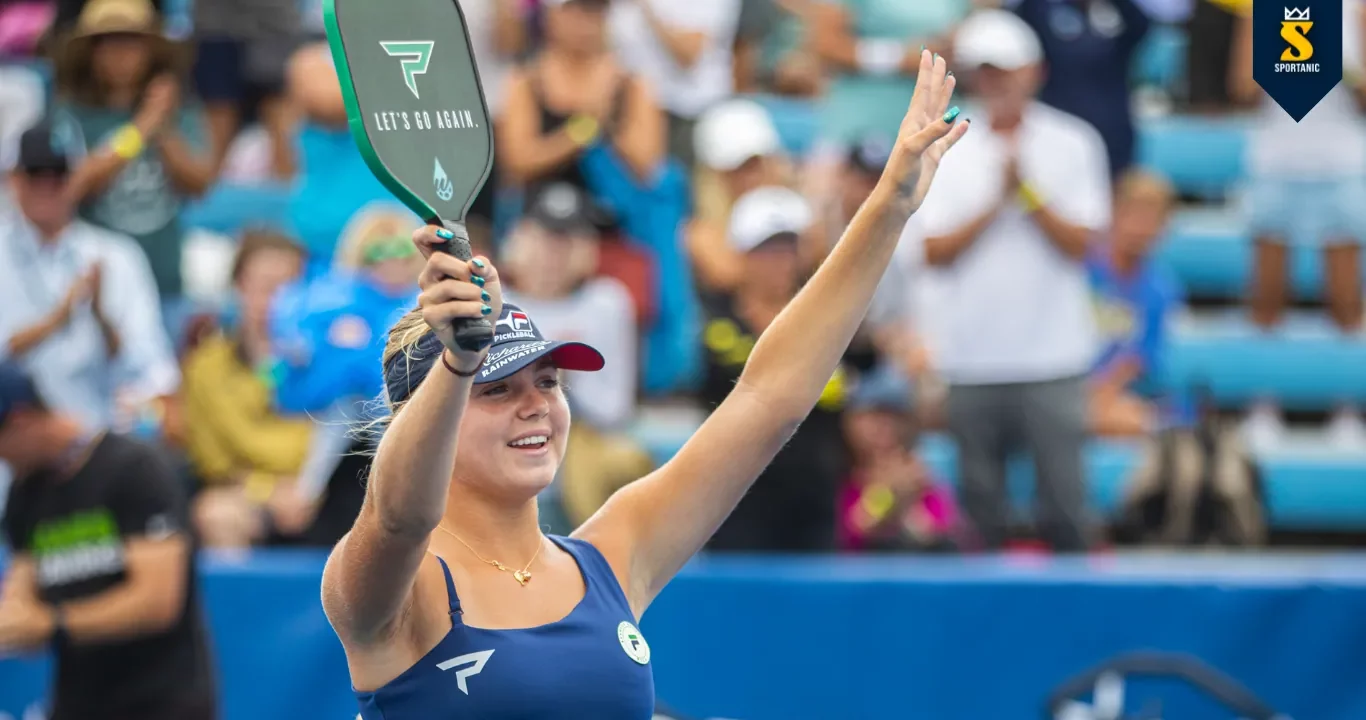
Pickleball, the fast-paced, paddle sport that’s been sweeping through local communities and recreation centres, has captured the hearts of players around the world. With its unique blend of tennis, badminton, and table tennis, it’s no wonder that enthusiasts are left wondering: “Is pickleball an Olympic sport?”
In this article, we’re going to dive into the exciting world of pickleball and explore whether it has secured its spot on the grandest stage of international sports. If you’re a pickleball aficionado or simply curious about the sport’s Olympic aspirations, here’s everything you need to know.
What is Pickleball and How to Play It?
Pickleball is a paddle sport that was invented in 1965 by three dads who wanted to entertain their bored kids.
They improvised with a badminton net, ping-pong paddles, and a perforated plastic ball. The game was named after Pickles, the family dog who loved to chase the ball.
Pickleball is played on a court similar to a badminton court, with a net at 36 inches high. The court is divided into two halves by a centerline, and each half has a non-volley zone (also called the kitchen) that extends 7 feet from the net. Also when searching for pickleball court near me, check if it has the kitchen no-volley zones. The game can be played as singles or doubles.
The basic rules of pickleball are:
- The serve is made diagonally from behind the baseline, underhand, and below the waist. The server must hit the ball in the air without bouncing it. The serve must land in the opposite diagonal court beyond the non-volley zone.
- Only one serve attempt is allowed, except for the first serve of each side at the beginning of each game.
- The server continues to serve until a fault is made by the serving team. A fault is any action that stops play because of a rule violation, such as hitting the ball out of bounds, into the net, or into the non-volley zone on a serve.
- The receiving team must let the serve bounce before returning it. This is called the two-bounce rule. After that, both teams can either volley (hit the ball in the air) or groundstroke (hit the ball after one bounce). However, no volleying is allowed within the non-volley zone, unless the ball bounces there first.
- The game is played to 11 points, and a team must win by two points. Points are only scored by the serving team.
The History and Popularity of Pickleball in the US and Around the World
Pickleball was first played in Bainbridge Island, Washington, by Joel Pritchard, Bill Bell, and Barney McCallum. They created the game as a way to keep their kids busy during a summer weekend. The game soon spread to their friends and neighbors, and eventually to other states and countries.
According to the USA Pickleball Association, there are over 3.3 million pickleball players in the US as of 2020, with an annual growth rate of over 10%. There are also over 26,000 pickleball courts across all 50 states. Pickleball is especially popular among seniors, as it offers low-impact exercise and social interaction.
Pickleball is also gaining popularity around the world, with official associations and federations in countries such as Canada, Mexico, India, Japan, Spain, France, UK, Australia, and more.
The International Federation of Pickleball (IFP) was founded in 2010 to promote and govern the sport globally. The IFP organizes international tournaments and events, such as the Bainbridge Cup, the World Pickleball Championship, the World Team Cup.
Criteria and Process for a Sport to Join the Olympics
The Olympics are the ultimate dream for many athletes and sports fans around the world. But how does a sport become an Olympic sport? What are the criteria and process involved?
The International Olympic Committee (IOC) is the supreme authority of the Olympic movement. It is responsible for selecting which sports are included in each edition of the Olympic Games. The IOC has established some general criteria for a sport to be eligible for Olympic recognition:
- The sport must be widely practiced by men in at least 75 countries and on four continents, and by women in at least 40 countries and on three continents.
- The sport must have an international federation that governs it according to the Olympic Charter and follows the World Anti-Doping Code.
- The sport must have a consistent history of world or continental championships or other major international competitions.
- The sport must add value to the Olympic Games by appealing to young people, media, spectators, sponsors, etc.
- The sport must not be similar to an existing Olympic sport or discipline.
The process for a sport to join the Olympics is complex and lengthy. It involves several steps and stages, such as:
- The international federation of the sport must apply for IOC recognition and submit a detailed questionnaire about the sport’s history, rules, structure, popularity, development, etc.
- The IOC Executive Board reviews the application and decides whether to grant provisional recognition to the sport. This allows the sport to receive funding and support from the IOC and participate in some IOC events, such as the Youth Olympic Games.
- The IOC Programme Commission evaluates the sport’s suitability for the Olympic Games based on various criteria, such as universality, gender equality, youth appeal, sustainability, etc. The commission also considers the impact of adding a new sport on the existing Olympic programme, such as the number of athletes, events, medals, venues, etc.
- The IOC Executive Board reviews the evaluation report and decides whether to propose the sport for inclusion in the Olympic Games. The proposal must be made at least seven years before the edition of the Games in question.
- The IOC Session, which is the general assembly of all IOC members, votes on whether to approve the proposal by a simple majority. The vote takes place during an IOC Session that precedes the edition of the Games in question by at least two years.
Why Pickleball is Not an Olympic Sport Yet and What are the Challenges
Pickleball is not an Olympic sport yet because it has not met the criteria and gone through the process of becoming one. As of 2021, pickleball is not even recognized as a sport by the IOC, which is the first step towards Olympic inclusion. This means that pickleball does not have an IF that is affiliated with the IOC and that follows its rules and regulations.
One of the main challenges for pickleball to become an Olympic sport is to establish a unified and credible IF that can represent and govern the sport at the international level. Currently, there are several organizations that promote and regulate pickleball in different regions and countries, such as the International Federation of Pickleball (IFP), the USA Pickleball Association (USAPA), the European Pickleball Association (EPA), and the All India Pickleball Association (AIPA).
However, these organizations are not officially recognized by the IOC and do not have a common vision or strategy for developing and expanding the sport globally.
Another challenge for pickleball to become an Olympic sport is to demonstrate that it meets the criteria of popularity, universality, value, and appeal that the IOC requires. Although pickleball has grown rapidly in recent years, especially in North America, it still lacks widespread recognition and participation in many parts of the world.
According to the IFP, there are only about 40 countries that have pickleball players and associations. This falls short of the minimum requirement of 75 countries for men and 40 countries for women that the IOC demands.
Future Prospects of Pickleball in the Olympics and How to Support It
Despite these challenges, pickleball has some advantages and opportunities that could help it achieve its Olympic dream in the future. Some of these are:
- High potential for growth and development. Pickleball is a relatively new and evolving sport that has a lot of room for improvement and innovation. It can adapt to different environments, cultures, and preferences. It can also benefit from technological advances and social media platforms that can enhance its performance, accessibility, and appeal.
- High appeal to young people and seniors. Pickleball is a sport that can attract and retain a wide range of participants across different age groups. It is especially appealing to young people who are looking for fun, social, and inclusive activities. It is also appealing to seniors who are looking for low-impact exercise and healthy aging.
- High compatibility with other sports. Pickleball is a sport that can complement and coexist with other sports rather than compete with them. It can share facilities, equipment, players, coaches, officials, etc. with other racket sports such as tennis, badminton, table tennis, etc. It can also offer cross-training benefits and opportunities for athletes from other sports.
- High support from passionate community. Pickleball has a loyal and enthusiastic community of players, fans, volunteers, organizers, promoters, etc. who are dedicated to growing and supporting the sport at all levels. They are willing to invest their time, money, energy, skills, etc. to make pickleball more accessible, attractive, and successful.
If you are a pickleball lover who wants to see pickleball in the Olympics someday, here are some ways you can help:
- Play pickleball regularly and invite others to join you. The more people play pickleball, the more popular and visible it becomes.
- Support pickleball organizations and events at the local, national, and international levels. The more pickleball is organized and promoted, the more recognition and legitimacy it gains.
- Educate and advocate for pickleball among your friends, family, community, media, etc. The more people know about pickleball and its benefits, the more interest and support it generates.
- Follow and support the International Federation of Pickleball (IFP) and its initiatives to grow and develop the sport globally. The IFP is the official representative of pickleball to the IOC and other international bodies.
- Participate in or watch international pickleball tournaments and events, such as the Bainbridge Cup, the World Pickleball Championship, the World Team Cup, and the World Senior Games. These events showcase the best of pickleball and its potential as an Olympic sport.
Well, That’s a Wrap
While pickleball may not have yet found its way into the Olympic Games, it’s certainly on the radar of the sports world. With its growing popularity, international tournaments, and dedicated community, it’s only a matter of time before pickleball takes its place alongside other Olympic disciplines.
Until then, let’s continue to enjoy this engaging and inclusive sport, both as players and spectators, and stay tuned for its potential journey to the world’s biggest sporting event.
Whether you’re a seasoned pickleball player or a curious onlooker, the future of this dynamic sport is something to keep an eye on.







